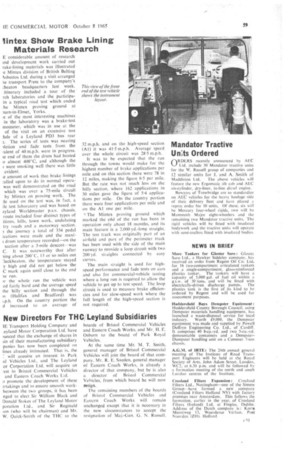lintex Show. Brake Lining Materials Research
Page 61

If you've noticed an error in this article please click here to report it so we can fix it.
E considerable amount of research tnd development work carried out rake-lining materials was illustrated ic Mintex division of British Belting ksbestos Ltd. during a visit arranged hie transport Press to the company's :heaton headquarters last week. itinerary included a tour of the rch laboratories and the participain a typical road test which ended be Mintex proving ground at ,urn-in-Elmet, Yorks.
ie of the most interesting machines in the laboratory was a brake-test monieter, which was in use at the of the visit on an extensive test Jule of a Leyland PD3 bus rear The series of tests was nearing iletion and' fade tests from the ralent of 40 m.p.h. were in progress. le end of them the drum had heated o almost 400°C, and although the ; were smoking well there was little evident.
he amount of work that brake linings :ailed upon to do in normal operawas well demonstrated on the road which was over a 75-mile circuit by Mintex on proving work. The le used on the test was, in fact, a ile test laboratory and was based on eyland Worldmaster p.s.v. chassis. route included four distinct types of itions, hills, town work, undulating try roads and a motorway section. the journey a total of 334 pedal ications were made and the maxidrum temperature recorded—on the section after a 3-mile descent--was C. It was noteworthy that after ling about 200C, 13 or so miles out :leckheaton. the temperature stayed y high and did not get below the C mark again until close to the end le run.
ir the whole run the vehicle was ed fairly hard and the average speed the hilly section and through the is (Halifax and Bradford) was i.p.h. On the country portion the d increased to an average of
32 m.p.h. and on the high-speed section (Al) it was 41-5 m.p.h. Average speed over the whole circuit was 28-5 m.p.h.
It was to be expected that the run through the towns would make for the highest number of brake applications per mile and on this section there were 78 in 12 miles, making the figure 6.5 per mile. But the rate was not much less on the hilly section, where 162 applications in 30 miles gave the figure o15'4 applications per mile. On the country portion there were four applications per mile and on the Al one per mile.
The Mintex proving ground which marked the ead of the run has been in operation only about 18 months, and its main feature is a 2.000 yd.-long straight. The test track was originally part of an airfield and part of the perimeter track has been used with the side of the main runway to provide a loop circuit with two 200 yd. straights connected by easy curves.
The main straight is used for highspeed performance and fade tests on cars and also for commercial-vehicle testing where a long run is required to allow the vehicle to get up to test speed. The loop circuit is used to measure brake efficiencies and for slow-speed work where the full length of the high-speed section is not required.


















































































































































